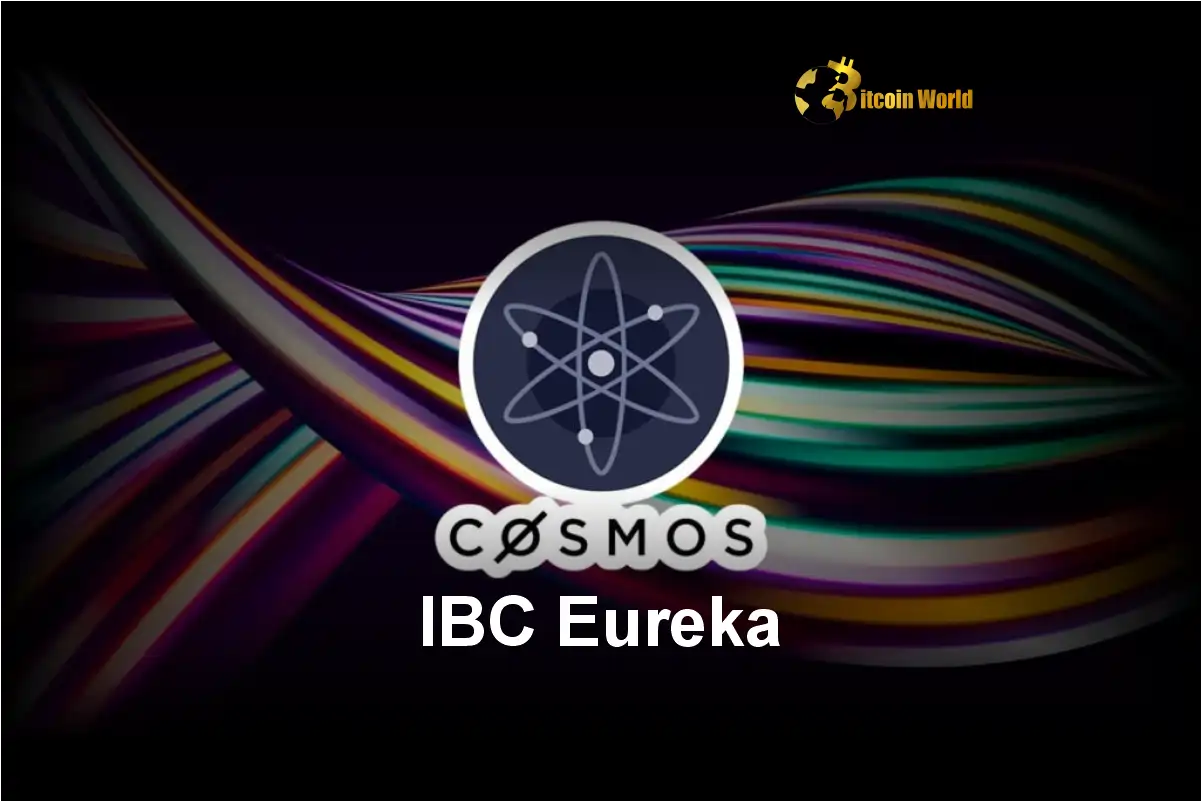Exciting news for the crypto community! Imagine a world where blockchains communicate effortlessly, unlocking unprecedented opportunities for growth and innovation. That future is becoming a reality as Interchain Labs, the driving force behind Cosmos, has just launched IBC Eureka, a groundbreaking bridge that directly connects Ethereum to the expansive Cosmos ecosystem. This is not just another bridge; it’s a potential game-changer, marking a significant leap towards true blockchain interoperability and opening doors for developers and users alike.
What is the Buzz About the Ethereum Cosmos Bridge?
For years, the crypto space has been buzzing about interoperability – the ability for different blockchains to talk to each other. Think of it like different countries finally agreeing on a universal language to facilitate trade and collaboration. In the blockchain world, this means breaking down silos and allowing assets and data to flow freely between networks. The Ethereum Cosmos bridge, powered by IBC Eureka, is a monumental step in this direction.
Here’s what makes this launch so significant:
- First of its kind: Ethereum, the second-largest cryptocurrency by market cap and a hub for decentralized applications (dApps), is now the first non-Cosmos chain to join the Inter-Blockchain Communication (IBC) protocol, thanks to IBC Eureka.
- Cost-Effective Transfers: Say goodbye to exorbitant bridging fees! IBC Eureka is designed to drastically reduce transfer costs, bringing them down to under $1. This affordability is crucial for mass adoption and everyday use.
- Expanding Interoperability: Interchain Labs isn’t stopping at Ethereum. They have ambitious plans to extend IBC Eureka’s reach to other major blockchains like Solana, Base, and Arbitrum, further solidifying Cosmos’s position as a central hub in the interconnected blockchain landscape.
- Early Backing: Prominent projects within the crypto space, including dYdX, MANTRA, Lombard, and Babylon, are already on board as early adopters, signaling strong confidence in IBC Eureka’s potential.
Why is Blockchain Interoperability Crucial?
Blockchain interoperability is not just a technical buzzword; it’s the key to unlocking the full potential of decentralized technology. Imagine a world where you can seamlessly move your digital assets, data, and even identities across different blockchain networks without friction. This interconnectedness offers a multitude of benefits:
- Enhanced Liquidity: Breaking down barriers between blockchains creates larger, more liquid markets. Assets can flow freely to where they are needed most, improving efficiency and reducing price slippage.
- Greater Innovation: Interoperability fosters collaboration and innovation. Developers can leverage the unique strengths of different blockchains to build more powerful and versatile applications. Imagine dApps that seamlessly combine the smart contract capabilities of Ethereum with the speed and scalability of Cosmos chains.
- User Empowerment: Users gain more control and flexibility. They are no longer confined to a single blockchain ecosystem and can choose the best platform for their specific needs, moving assets and data as they see fit.
- Scalability Solutions: As the blockchain space grows, interoperability becomes essential for scalability. By connecting different chains, we can distribute the load and avoid network congestion, leading to faster and more efficient transactions.
The launch of IBC Eureka directly addresses these crucial aspects, paving the way for a more connected and efficient blockchain future.
Interchain Labs: Pioneers of the Cosmos Ecosystem
Interchain Labs is the core development team behind the Cosmos network, a decentralized ecosystem of independent, scalable, and interoperable blockchains. They are the architects of the Cosmos SDK, a modular framework that simplifies the process of building custom blockchains, and the creators of the Tendermint consensus engine, known for its speed and security.
Their commitment to blockchain interoperability is evident in their development of the IBC protocol, which serves as the foundation for IBC Eureka. Interchain Labs envisions a future where blockchains are seamlessly interconnected, much like the internet itself, enabling a new era of decentralized applications and services.
By launching IBC Eureka, Interchain Labs is not only expanding the Cosmos ecosystem but also contributing significantly to the broader crypto space by demonstrating the practical implementation and benefits of cross-chain communication.
Unpacking the Benefits of IBC Eureka
The arrival of IBC Eureka brings a wave of advantages to both the Ethereum and Cosmos ecosystems, and to the wider crypto community:
| Benefit | Description |
|---|---|
| Reduced Transaction Costs | Transferring assets between Ethereum and Cosmos via IBC Eureka is significantly cheaper, costing less than $1 per transaction. This is a stark contrast to previous bridging solutions that often incurred high gas fees on Ethereum. |
| Increased Speed and Efficiency | IBC is known for its fast and efficient transaction processing. IBC Eureka leverages this to provide quicker transfer times compared to traditional bridging methods. |
| Enhanced Security | IBC is designed with security in mind. IBC Eureka benefits from the robust security features of the IBC protocol, offering a more secure way to bridge assets compared to some other less established bridges. |
| Wider Access to DeFi Opportunities | Ethereum users can now easily access the growing DeFi ecosystem within Cosmos, and vice versa. This opens up new avenues for yield farming, lending, borrowing, and other decentralized financial services. |
| Boosted Liquidity for Both Ecosystems | The bridge facilitates the flow of liquidity between Ethereum and Cosmos, benefiting projects and users in both ecosystems. This increased liquidity can lead to more stable markets and better trading opportunities. |
These benefits collectively contribute to a more user-friendly, efficient, and interconnected blockchain environment.
How Does a Cross-Chain Bridge Like IBC Eureka Work?
Understanding how a cross-chain bridge functions is key to appreciating the innovation behind IBC Eureka. Essentially, a cross-chain bridge acts as a translator and conduit between two separate blockchain networks. Here’s a simplified overview:
- Locking/Burning Assets: When you want to move assets from one chain (e.g., Ethereum) to another (e.g., Cosmos), the bridge typically locks or burns the assets on the origin chain. Locking involves holding the assets in a smart contract, while burning destroys them and reduces the total supply on that chain.
- Message Relaying: The bridge uses a mechanism to relay information about the locked or burned assets to the destination chain. In the case of IBC, this is done through relayers who transmit packets of information between chains.
- Minting/Unlocking Assets: On the destination chain, the bridge mints or unlocks a corresponding representation of the assets that were locked or burned on the origin chain. Minting creates new assets on the destination chain, while unlocking releases assets that were previously locked.
- Two-Way Communication: A robust bridge like IBC Eureka enables two-way communication, allowing for seamless asset and data transfer in both directions between the connected blockchains.
IBC Eureka, leveraging the IBC protocol, implements these steps in a secure and efficient manner, ensuring reliable and cost-effective cross-chain transactions between Ethereum and Cosmos.
Early Adopters and Exciting Use Cases
The rapid adoption of IBC Eureka by key players in the crypto space speaks volumes about its potential. Projects like dYdX, MANTRA, Lombard, and Babylon are among the early adopters, eager to leverage the benefits of this new bridge.
- dYdX: A leading decentralized exchange, dYdX can benefit from IBC Eureka by potentially expanding its reach to the Cosmos ecosystem and offering users access to a wider range of assets and trading opportunities.
- MANTRA: A vertically integrated and regulatory compliant blockchain for finance, MANTRA can utilize IBC Eureka to enhance its cross-chain capabilities and connect with the Ethereum DeFi ecosystem.
- Lombard: Focusing on institutional-grade crypto lending and borrowing, Lombard can leverage IBC Eureka to facilitate cross-chain lending and borrowing activities, increasing efficiency and accessibility for institutional clients.
- Babylon: A project focused on Bitcoin staking, Babylon’s involvement highlights the broader implications of IBC and its potential to connect even Bitcoin to the Cosmos ecosystem in the future.
Beyond these early adopters, IBC Eureka opens up a vast array of use cases:
- Cross-Chain DeFi: Seamlessly move assets between Ethereum and Cosmos DeFi platforms to optimize yields and access diverse financial instruments.
- NFT Interoperability: Potentially enable the transfer of Non-Fungible Tokens (NFTs) between Ethereum and Cosmos chains in the future, unlocking new possibilities for NFT marketplaces and applications.
- Data and Information Exchange: Facilitate the secure and efficient exchange of data and information between Ethereum and Cosmos-based applications, fostering collaboration and innovation.
- Gaming and Metaverse Applications: Create more immersive and interconnected gaming and metaverse experiences by allowing assets and identities to move freely between different blockchain environments.
What’s Next for IBC Eureka and Cross-Chain Bridges?
The launch of IBC Eureka is just the beginning. Interchain Labs has ambitious plans to expand its reach, with Solana, Base, and Arbitrum already on the roadmap for future integrations. This expansion will further solidify Cosmos’s position as a central hub in the multi-chain universe and unlock even greater levels of interoperability.
Looking ahead, we can expect to see:
- More Blockchain Integrations: Continued efforts to connect more blockchains to the IBC network, creating a truly interconnected web of decentralized networks.
- Advanced Bridge Features: Development of more sophisticated bridge functionalities, including support for complex smart contract interactions and cross-chain data oracles.
- Standardization of Interoperability Protocols: Increased collaboration and standardization efforts across the industry to create universal interoperability protocols that can be adopted by various blockchain projects.
- Growing Ecosystem of Interoperable Applications: An explosion of new dApps and services that leverage cross-chain bridges to offer users seamless and integrated experiences across multiple blockchain platforms.
While challenges remain, such as ensuring robust security and managing the complexity of cross-chain interactions, the momentum behind cross-chain bridge technology is undeniable. IBC Eureka is a powerful example of the innovation driving the blockchain space forward, promising a future where interoperability is not just a dream, but a fundamental reality.
Conclusion: A Giant Leap Towards a Connected Blockchain Future
The launch of IBC Eureka by Interchain Labs is more than just a new bridge; it’s a revolutionary step towards a truly interconnected blockchain ecosystem. By bringing Ethereum into the Cosmos fold, and with plans to expand to other major chains, IBC Eureka is paving the way for a future where blockchains communicate seamlessly, unlocking unprecedented opportunities for innovation, efficiency, and user empowerment. The era of blockchain silos is fading, and the dawn of interoperability is upon us, promising a more collaborative and dynamic decentralized world.
To learn more about the latest crypto market trends, explore our article on key developments shaping Ethereum price action.
[ad_2]
Source link






